#final impact 1992
Explore tagged Tumblr posts
Text
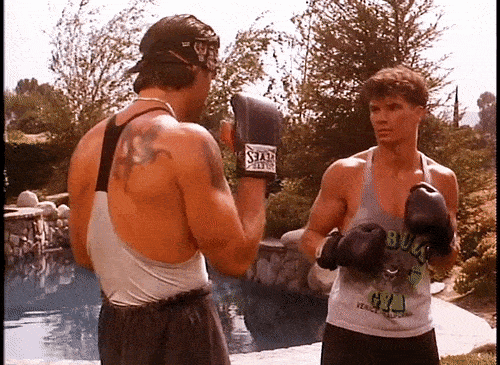

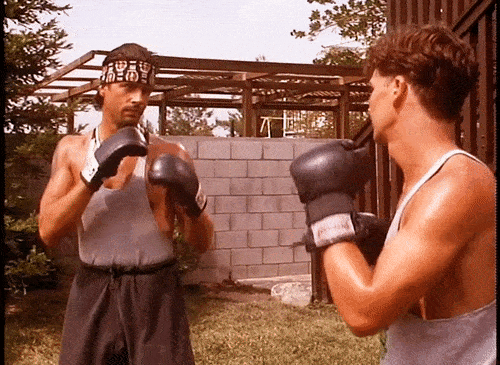
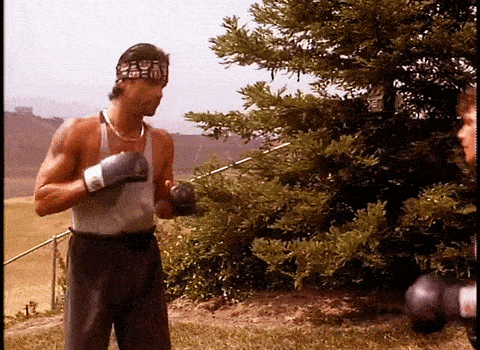
FINAL IMPACT (1992) dir. Joseph Merhi, Stephen Smoke
#final impact#final impact 1992#movies#90s#my gifs#gifs#gifset#soupy's#filmgifs#filmedit#filmdaily#kickboxing#lorenzo lamas#michael worth#tvandfilm#cinematv#cinemapix#fyeahmovies
29 notes
·
View notes
Text
youtube
Shaquille O’Neal's Basketball Hall of Fame Enshrinement Speech! #shaq #hof #halloffame #speech #nba24highlights #NBA24Highlights
Shaquille O’Neal delivers his Speech upon being Enshrined to the Naismith Memorial Basketball Hall of Fame as part of the Class of 2016. This was one of the Greatest HOF Speeches ever given for Basketball. This guy literally thanked everyone from beginning to the end in order, this is the way it's supposed to be done. Congrats Shaq, I watched you and Penny make magic, I watched you and Kobe make magic, and I saw you and Dwyane make Magic, it was a hell of a journey, I'm excited to see where you're future will take you, we'll be talking about Shaq for as long as he's living and beyond Shaquille Rashaun O’Neal was always the biggest kid on the court. From his days as a McDonald’s High School All-America to his backboard-shattering days in the NBA, the man with the endless Rolodex of nicknames and dance moves was known as much for his fun-loving attitude as his basketball ability. A two-time unanimous First Team All-America at LSU and 1992 National Player of the Year, the Orlando Magic made Shaq the number one overall pick of the 1992 NBA Draft. Shaq’s impact was immediate, earning Rookie of the Year honors in 1993 and later leading the Magic to the 1995 NBA Finals. He would then become a member of the Los Angeles Lakers, where he teamed up with Kobe Bryant and Phil Jackson to win three NBA championships in three years. O’Neal was named Finals MVP in each series. Next stop was Miami, where Shaq again earned an NBA title in 2006 and a seventh consecutive spot on the All-NBA First Team. He won Olympic gold in 1996, led the NBA in scoring average twice, and somehow managed to keep his sense of childlike wonder through it all. #nba24highlights #NBA24Highlights
#Shaquille O’Neal delivers his Speech upon being Enshrined to the Naismith Memorial Basketball Hall of Fame as part of the Class of 2016. Thi#this is the way it's supposed to be done. Congrats Shaq#I watched you and Penny make magic#I watched you and Kobe make magic#and I saw you and Dwyane make Magic#it was a hell of a journey#I'm excited to see where you're future will take you#we'll be talking about Shaq for as long as he's living and beyond Shaquille Rashaun O’Neal was always the biggest kid on the court. From hi#the man with the endless Rolodex of nicknames and dance moves was known as much for his fun-loving attitude as his basketball ability. A tw#the Orlando Magic made Shaq the number one overall pick of the 1992 NBA Draft. Shaq’s impact was immediate#earning Rookie of the Year honors in 1993 and later leading the Magic to the 1995 NBA Finals. He would then become a member of the Los Ange#where he teamed up with Kobe Bryant and Phil Jackson to win three NBA championships in three years. O’Neal was named Finals MVP in each ser#where Shaq again earned an NBA title in 2006 and a seventh consecutive spot on the All-NBA First Team. He won Olympic gold in 1996#led the NBA in scoring average twice#and somehow managed to keep his sense of childlike wonder through it all.#nba24highlights#NBA24Highlights#nbahighlights#NBA#BASKETBALL#FIGHT#BRAWL#FUNNY#BLOOPERS#REACTION#ALL STAR#DUNKCONTEST#GAMEWINNER#BUZZERBEATER#LIVE
0 notes
Note
bucket here
I’d just like to note that the instant I sent the ask I started writing in the hopes you would say yes and I like actually squeaked I was so happy when you did and also I’ve been writing nonstop since then so bear with me:
*takes deep breath* Safety restrictions were famously lax in F1 until the 1990s. The deaths of Roland Ratzenberger and Ayrton Senna within days of each other at the 1994 Imola GP sparked a huge movement for new safety systems, especially barrier changes. As Senna and Ratzenburger both died in accidents related to the fact that the safety barriers at the edges of tracks were just CEMENT WALLS, this was a huge push for many teams, drivers, and tracks. No one wanted the death of more legends on their hands. These accidents also inspired additions like headrests in 1996 and the HANS system (head and neck support), put in place in 2003. HANS can be seen when drivers get out of the car — it’s that space-age looking neck brace/strap on their shoulders and helmet.
Some safety systems that are much less talked about are things like the accelerometer, first used in 2014 and placed in the drivers ear. This measures the forces during impacts, and its location in the ear allows both for less invasive placement and accurate data on head/neck movement for drivers. This then leads to better safety systems capable of being studied, reasoned for, and implemented. The addition in 2016 of a camera that faces the driver also allows for safety teams to see exactly how the driver is affected during crashes, as well as giving fans a fun camera angle (which I can rant about as well, camera angles in F1 are a huge thing for me).
Rapid fire safety systems (there will be a quiz):
Helmets were first introduced in 1952, but not required until 1977.
Seatbelts/racing harnesses required starting 1972.
Fireproof race suits have been required since 1975.
The safety car didn��t even exist until 1993 (trial runs in 1992, first seen in 1973 Canadian GP)
Pit lane speed limit introduced in 1994. Yes, before this they just ripped through as fast as they could; no, the pit crews didn’t stand any further away.
Wheel tethers introduced in 1999 after an unholy amount of incidents going back to pre-1950 (AKA official F1 start) where the wheels just came off and smacked drivers, marshals, and fans, usually killing them instantly.
The most notable safety system recently is the Halo and VSC (virtual safety car). The halo was put in place in 2018 and will hopefully never leave. It has been the savior of hundreds of lives throughout Formula series, but most well known in Formula 1 were Lewis Hamilton (2021 Monza GP, stopped Max Verstappen's car from becoming a permanent fixture in the side of his head) and Romain Grosjean (2020 Bahrain GP, pushed the crash fencing up away from his head as he hit the barriers), as well as possibly Zhou Guanyu (2022 British GP, flipped upside down and up over tire barriers into catch fencing) and Max Verstappen (2021 British GP, incredibly hard hit into a tire barrier — 51G impact at 160 MPH/257 KPH).
There had been a number of close calls that brought up the possibility of halos, like Fernando Alonso almost having his head removed from this world at Spa in 2012 on lap one, and an incident between Michael Schumacher and Vitantonio Luizzi at Abu Dhabi in 2010 that left Luizzi’s Force India inches from Schumacher’s face.
Unfortunately, it took the horrific death of Jules Bianchi in 2014 at the Japanese GP and a number of junior driver fatalities for the Halo to be finally seriously considered and implimented. Bianchi’s incident also led to the Virtual Safety car, which was put in place in 2015 to keep accidents like his from happening. I can talk more about his incident as well if you’d like. It’s a masterpiece of administrative fuck ups and terrible oversights.
(Ask me about it and camera angles I dare you)
HELLO BUCKET
this is wonderful thank u thank u
i did know a little about the senna crash (tho not the concrete barriers) (i do know that when it happened they were trying to revive the drivers union which is awful) and the bianchi crash (i looked at that quite extensively for update post) but Yeesh yeah the safety stuff is Terrifying. pls. pls tell me about the camera angles.
106 notes
·
View notes
Text
Hi pookies!
On this account, I’ll be talking about Visual Kei, its history, and popular bands! 🎤🎸
(I’m new to this app, soo a lot of things are still a bit confusing for me 🙏🏻) There's not much info about Visual Kei online, and it’s often hard to find, so if I can help anyone interested in this topic, I'd be super happy !! ᕦ༼✩ل͜✩༽ᕤ
!!
Before We Begin: I apologize for any spelling mistakes, as English isn’t my first language. 🙇♀️
This post will include: What Visual Kei is, Visual Kei genres, and information about Visual Kei bands.
Okay class, first lesson!! (≧▽≦)
What is Visual Kei?
Visual Kei (Vkei) is a music and fashion subculture that originated in Japan. The term "visual style" refers to a concept that involves not just music but also dramatic stage costumes, makeup, and overall aesthetics. It was popularized in the late 1980s and early 1990s by bands like X Japan.
1. Visuals: Vkei artists often dress in androgynous styles that challenge gender norms. Expect colorful hair, exaggerated costumes, dramatic makeup, and theatrical accessories!
2. Music Genre: Vkei bands generally blend rock and metal influences with other genres like punk, pop, gothic, etc.
3. Performance: Stage performances are theatrical, often focusing on storytelling and creating a dramatic atmosphere.
Sub-genres:
1. Eroguro Kei (Erotic-Grotesque Kei):
Features: As the name suggests, Eroguro Kei combines erotic and grotesque elements. It is known for its dark and disturbing aesthetic. Costumes are often scary, vampiric, or horror-themed. Stage performances frequently include images of fear, death, and taboo subjects.
Examples: Some periods of Malice Mizer and the early years of Dir En Grey(visual kei era) MAYBE close to this style.
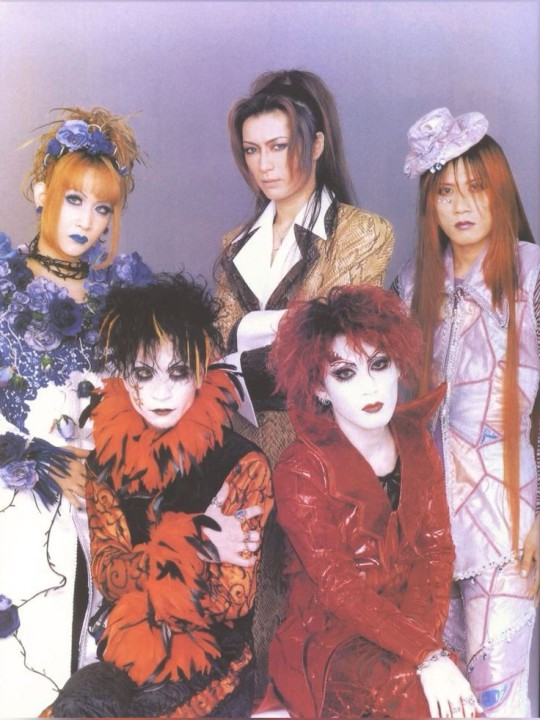
Malice Mizer ☆
Genre: Gothic Rock, Baroque Pop
Active Years: 1992 - 2001
About:
Known for their gothic and theatrical style, the band pushed visual elements to the extreme. The era with Gackt as the vocalist is particularly famous. Iconic songs include "Beast of Blood" and "Bel Air."
Career Summary:
Malice Mizer debuted in 1992, creating a legacy with their gothic, baroque, and theatrical approach. Over their career, they went through three different vocalists, each bringing unique styles. Their most famous era was with Gackt as the vocalist (1995–1999). After the death of drummer Kami in 1999, the band eventually disbanded in 2001. Despite their short lifespan, they are considered one of the most iconic Visual Kei bands.

Dir en Grey
Genre: Alternative Metal, Progressive Rock
Active Years: 1997 - present
About:
With a darker and more experimental sound, the band has transcended the boundaries of Visual Kei, gaining an international fan base. Songs like "Obscure" and "The Final" have had a massive impact on the Visual Kei scene.
Career Summary:
Starting in 1997 as a more traditional Visual Kei band, Dir en Grey quickly evolved into a group with a darker, more experimental sound. They have toured extensively in Europe and the US, building a global fan base. Albums like "Withering to Death" and "Uroboros" showcase their transition into alternative and progressive metal, solidifying their status as an innovative force in rock music.
2. Kote Kei:
Features: Kote Kei represents the traditional and classic style of Visual Kei. In this subgenre, stage performances and costumes are usually darker and more serious. Black, red, and metallic colors are typically prominent. The fashion consists of costumes that combine both masculine and feminine elements, often with gothic touches.
Examples: X Japan and early Luna Sea can be considered examples of this style.

X Japan
Genre: Heavy Metal, Progressive Rock
Active Years: 1982 - present (with breaks)
About:
Pioneers of Visual Kei and one of the most influential bands in introducing this subculture to the world.
Career Summary:
Formed in 1982 by Yoshiki and Toshi, X Japan is considered the pioneer of the Visual Kei movement. They gained immense popularity in the late 1980s and early 1990s with albums like "Blue Blood" and "Jealousy." After disbanding in 1997, the band reunited in 2007, continuing to perform globally. Their iconic song "Endless Rain" remains a Visual Kei anthem.
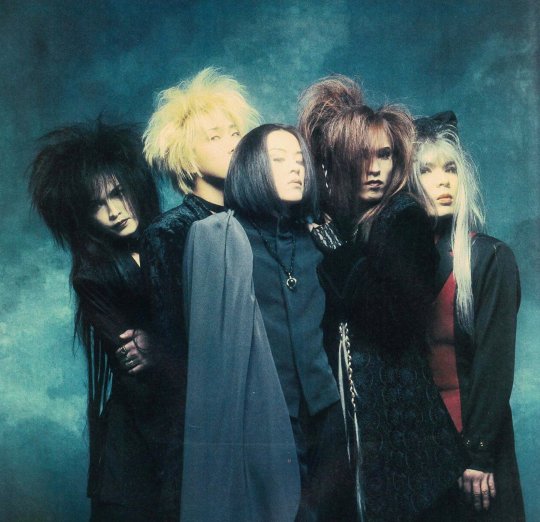
Luna Sea ✷
Genre: Rock, Progressive Rock
Active Years: 1989 - present
About:
One of the most influential bands in the Japanese rock scene, known for their softer and more melodic sound. Popular tracks include "Rosier" and "I for You."
Career Summary:
Formed in 1989, Luna Sea became a key figure in the Visual Kei scene. Their music blends melodic rock with progressive elements. They disbanded in 2000 but reunited in 2010 and have since continued to release new music and tour. Albums like "Mother" and "Shine" are iconic in their discography, and they remain a favorite in Japan's rock history.
3. Oshare Kei:
Features: Oshare Kei is the more cheerful, colorful, and energetic side of Visual Kei. In this subgenre, the clothing is generally in pastel tones, stylish, fun, and sometimes "kawaii" (cute). The music is lighter, energetic, and sometimes contains pop-rock elements. The stage performances focus more on fun than visual aesthetics.
Examples: Bands like An Cafe and SCREW can be considered examples of this subgenre.

An Cafe
Genre: Oshare Kei, Pop Rock
Active Years: 2003 - 2019 (with breaks)
About:
An Cafe (Antic Cafe) is one of the most well-known Oshare Kei bands, famous for their colorful and cheerful style. Their songs are often fun, energetic, and positive. Fans of the group are called "Cafekko."
Career Summary:
An Cafe debuted in 2003 and became a leader of the Oshare Kei movement in the mid-2000s. After a hiatus in 2010, they returned in 2012 but announced their disbandment in 2019, concluding with a farewell tour.

SCREW
Genre: Oshare Kei, Alternative Metal, Visual Kei
Active Years: 2006 - 2019
About:
SCREW is one of the heavier and darker Oshare Kei bands. Their music features emotionally intense lyrics combined with powerful riffs and melodic elements.
Career Summary:
Founded in 2006 by Byou and Jin, SCREW became a prominent name in the Visual Kei scene during the early 2010s. They disbanded in 2019 after 13 years.
4. Angura Kei:
Features: Angura Kei is a subgenre deeply connected to Japanese culture. This style blends traditional Japanese clothing (such as kimonos, samurai attire, etc.) with modern Vkei aesthetics. It is often inspired by Japanese history and culture.
Examples: Kagrra, and some older songs by PSYCHIC LOVER can be examples of this style.

Kagrra
Genre: Angura Kei, Neo-Japanese Rock
Active Years: 2000 - 2011
About:
Kagrra, is a standout band in the Angura Kei subgenre. Their music blends traditional Japanese instruments and melodies with modern rock and Visual Kei aesthetics. Their lyrics often draw inspiration from Japanese mythology, folklore, and history. Stage costumes frequently incorporate traditional Japanese styles like kimono and samurai themes.
Career Summary:
Debuting in 2000 as "CROW," they soon changed their name to "Kagrra,." The band disbanded in 2011, releasing their final album, "Hyakki Kenran." Tragically, vocalist Isshi passed away the same year. The group is considered a pioneer in fusing Japanese culture with modern music.

PSYCHIC LOVER
Genre: Rock, Anisong (Anime Songs), Angura Kei
Active Years: 1998 - present
About:
PSYCHIC LOVER is a well-known name in Japan’s anisong scene, particularly for their work on anime and tokusatsu (Japanese sci-fi series) themes. They combine traditional Angura Kei aesthetics with the energy of anisong. Their music is often high-tempo, with powerful vocals and energetic guitar riffs.
Career Summary:
The band rose quickly in the anisong scene in the early 2000s, gaining a dedicated fan base through their work on anime, Super Sentai, and tokusatsu projects. Their stage performances are dynamic and occasionally incorporate Japanese cultural elements in costumes and music videos, nodding to the Angura Kei style.
!!!
Each Vkei subgenre offers a different world in terms of both music and visuals. Simply labeling it as a "gothic stage" is an oversimplification. ☝🏻🤓
We’ve reached the end (╥﹏╥)
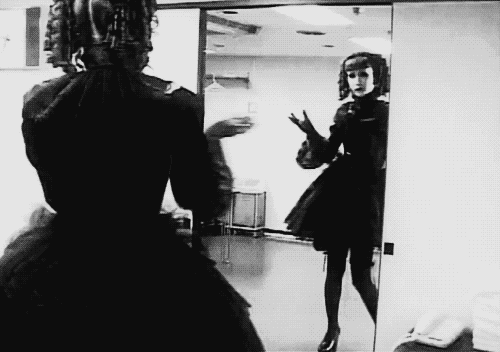
I’m finishing here. Honestlyy, if it were up to me, I’d write until morning, but I’m not sure if this will really reach people, so I don’t want to write for no reason. I’ll continue based on the interaction I get. If you have any questions, feel free to reach out to me.
I wish you all healthy days. ♡
Written by: manaberrysoup
#music#malice mizer#goth aesthetic#ouji fashion#ouji lolita#gothic#heavy metal#x japan#anime#goth#mana sama#band music#black metal#japan#jpop#jrockband#jrock#visual kei#kei#jpop idol#jrock icons#an cafe#transgender#oshare kei#luna sea#kote kei#eroguro#androgynous#japanese idol#metal
39 notes
·
View notes
Text

Given name: Toji Fushiguro
Role: Bassist of Gifted Curse
Birthday: December 31, 1992
Zodiac: Capricorn
Height: 6’2
Favorite color: Green
Favorite food: Ramen
Toji is the dynamic bass player and final founding member of the innovative band Gifted Curse. With a passion for music that has been a driving force throughout his life, Toji brings a unique blend of talent, creativity, and experience to the group. His journey in music took a significant turn when his former band disbanded, leading him to seek new artistic horizons. It was during this transitional period that he was discovered by Gifted Curse, a collective of like-minded musicians who shared his vision for pushing boundaries and exploring new sonic territories.
With a playful spirit and a knack for captivating audiences, Toji has earned a reputation as the biggest flirt of the band. His cheeky demeanor, both on stage and off, adds an infectious energy to performances, making every show a memorable experience for fans. Whether he’s engaging with the crowd or playfully bantering with bandmates, his charm enhances the band's dynamic, creating an atmosphere of fun and spontaneity.
Hailing from a diverse musical background, Toji's influences range from rock and funk to experimental and indie sounds. His intricate bass lines and rhythmic prowess have quickly become a hallmark of Gifted Curse's sound, adding depth and texture to the band’s captivating compositions. With an innate ability to connect with audiences, Toji's performances are not just about playing notes; they’re a visceral experience that invites listeners into the heart of the music.
Since joining Gifted Curse, Toji has become an integral part of the band’s journey, infusing each performance with his vibrant personality and undeniable talent. As the band continues to evolve and explore new creative directions, Toji remains committed to pushing boundaries and making meaningful connections through music. With his infectious enthusiasm and cheeky charm, he is not just a bassist; he’s a true showman, ready to leave a lasting impression on audiences everywhere.
As Gifted Curse continues to evolve, Toji remains committed to expanding his musical horizons and embracing new challenges. His journey is a testament to the power of resilience and the belief that every ending can lead to a new beginning. With his infectious enthusiasm and unwavering passion for music, Toji is poised to make a lasting impact in the industry and beyond.
Check back soon for exclusive content
< Meet the Band >
#jjk#anime#toji fushiguro#jjk toji#toji fanfic#toji zenin#jjk fanfic#jujutsu toji#jjktoji#giftedcursefanfic
24 notes
·
View notes
Text
"a disaster beyond description" - the parallax view on parallax (& coast city's destruction)
i've often talked about the importance of pre-parallax retcon hal jordan, what a radical move his downfall had been for an art medium so uniquely focused on status quo and how much walking that back in post-2005 continuity damaged the character & his development. however, something i've become increasingly interested in lately is the outsider point of view on the magnitude of coast city's destruction and hal's descent into madness -- the reverberations of one of the darkest days in the dcu were far and wide for a good long while there but rarely acknowledged outside of nostalgia pieces nowadays and even more rarely understood as a thoroughly visceral, well-written, well-planned arc that intentionally portrayed the superhero world as largely unsympathetic to the trauma of one of their own but the average civilian as grappling with that loss nearly on the same scale that hal did.
to that effect, i thought i would show a highlights reel of this outsider POV and how much it adds to the weight of the pre-2005 story. while i've accepted some tie-ins to major events (ie zero hour 1994, final night 1996), this will feature titles entirely unrelated to green lantern presented in real life chronological order by publication date in order to showcase the impact that's compelled me so (that's no convergence: green lantern, no legends of the dcu #33-36, etc).
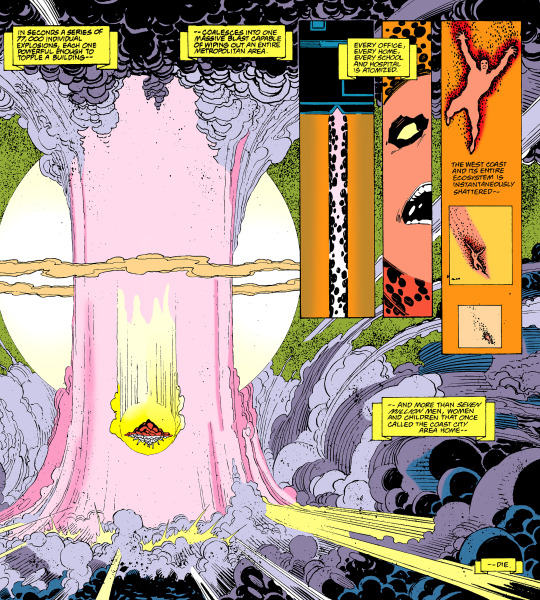

"every office, every home, every school and hospital is atomized. the west coast and its entire ecosystem is instantaneously shattered-- and more than seven million men, women and children that once called the coast city area home-- die."
to set the scene, the explosion that destroys coast city actually appears in superman 1987 #80 (cover date: aug 1993) as part of hank henshaw and mongul's plan.
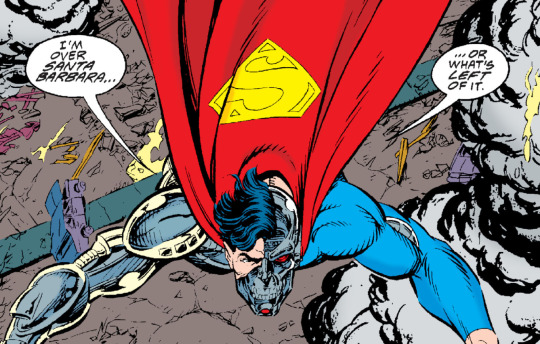
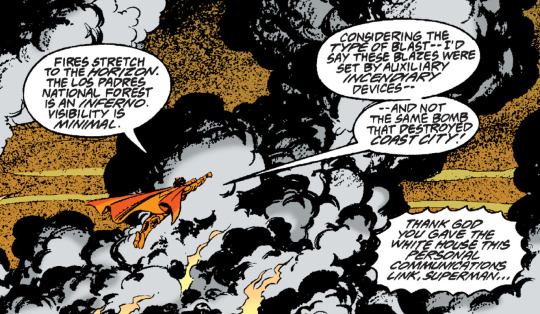
the destruction had spread as far as santa barbara & the los padres national forest. getting closer to ground zero, hank henshaw also proceeds to resolutely take care of a handful of the sole survivors:
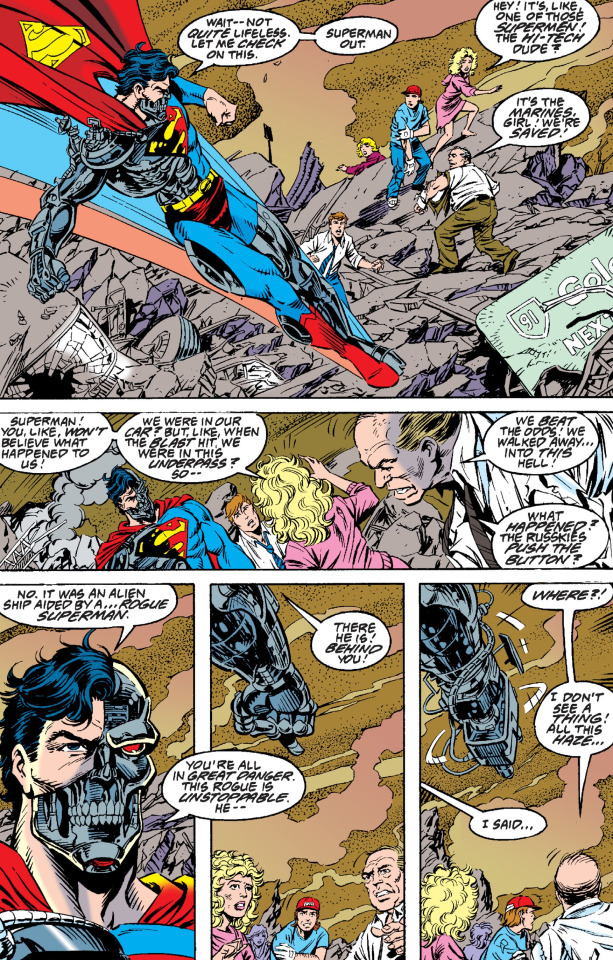
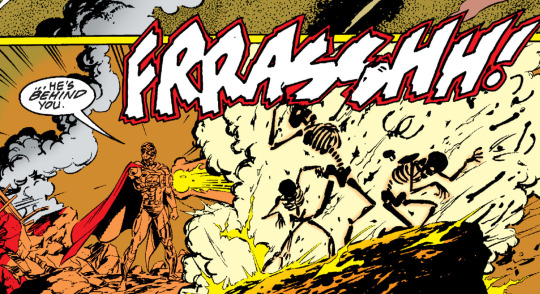
(adventures of superman 1987 #503, cover date: aug 1993)
you all know the reading order here. past the return of superman and the events of emerald twilight, the first outsiders to have gotten the news are the darkstars
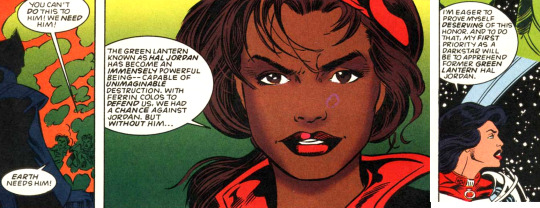
whose immediate course of action is to brand hal jordan a criminal (darkstars #23, cover date: aug 1994)
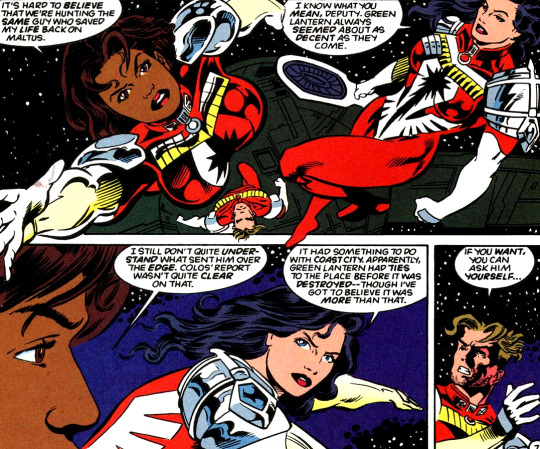
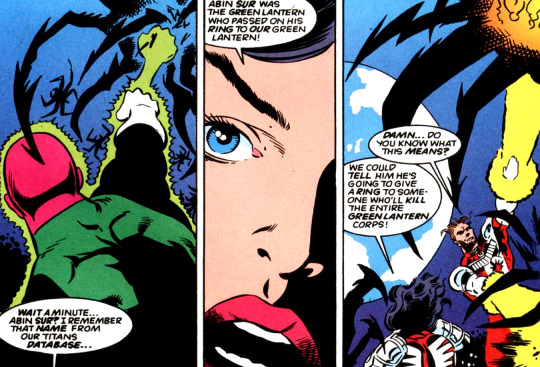
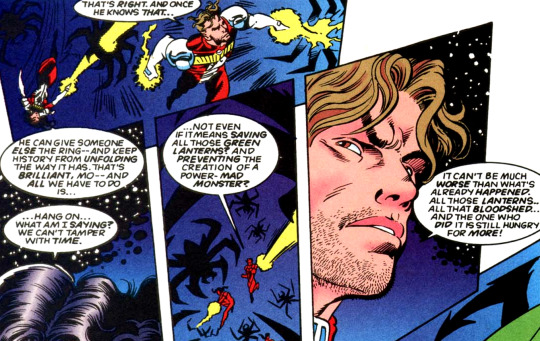
and as zero hour-induced temporal anomalies keep coming up, the darkstars start seriously considering further tampering with time in order to prevent "the creation of a power-mad monster" (darkstars #24, cover date: sept 1994).
it's a sentiment that the majority of hal's justice league colleagues share, as zero hour: crisis in time and the final night both tell us, but a more sympathetic view comes two years later in the spectre 1992 #47 (cover date: nov 1996)

and a more neutral one from waverider in superman: the doomsday wars #2 (cover date: dec 1998)
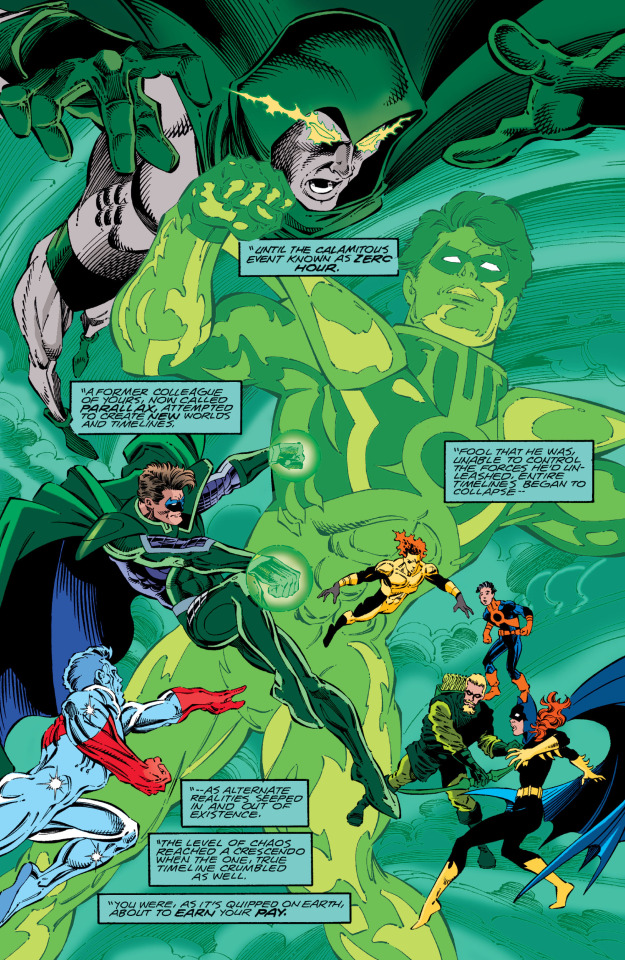
interestingly enough, more details of the in-universe perception of hal's actions comes from deadman: dead again

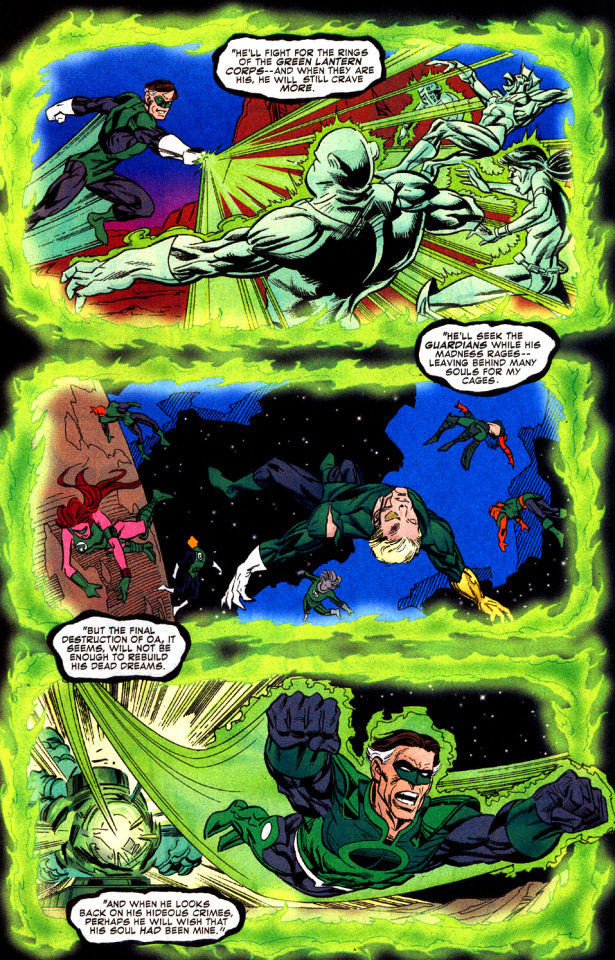
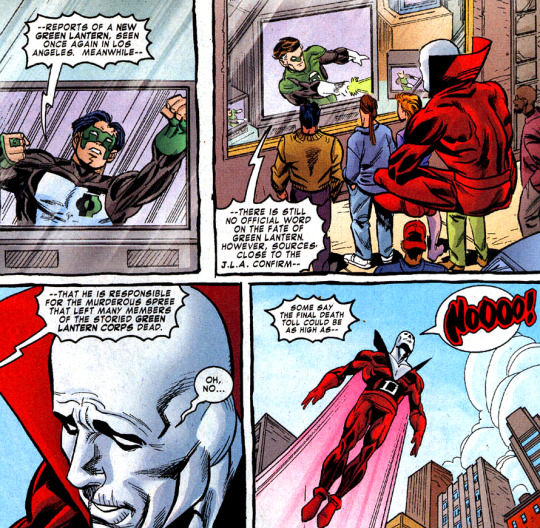
where we learn that "sources close to the JLA" have actually issued a press statement naming hal as wholly responsible for the green lantern corps massacre, with no hint that they've been equally forthcoming about the motive behind his actions (deadman: dead again #4, cover date: oct 2001)
the last pre-retcon word goes to superman: day of doom #3 (cover date: jan 2003), a sobering portrayal of the immense horror of coast city's annihilation and subsequently a look into the reality that had made hal snap:
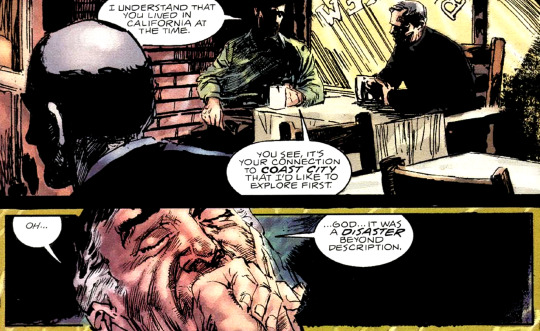
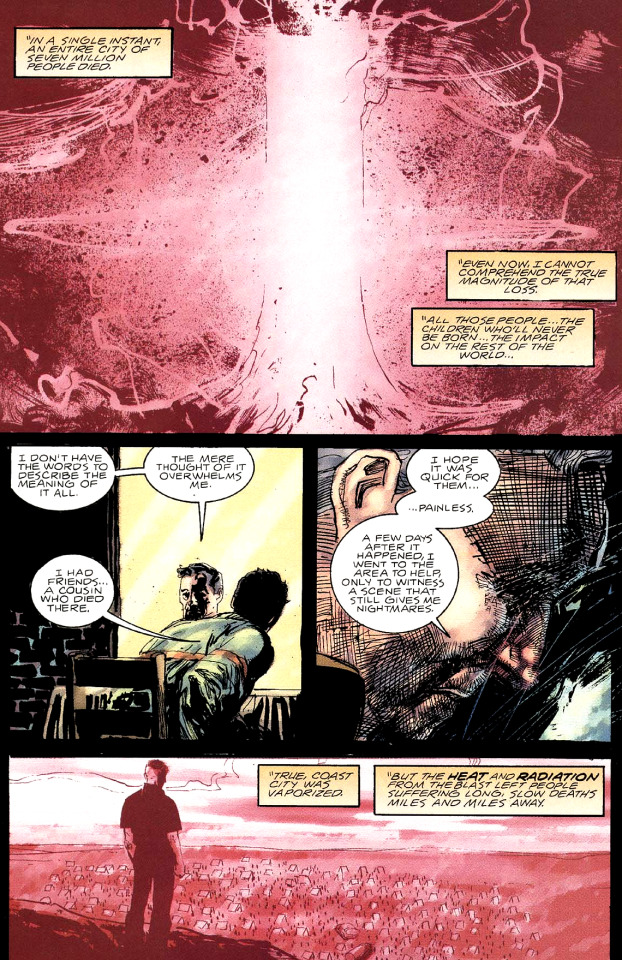
post-retcon, nostalgia pieces like dcu: legacies #8 (feb 2011) and dc retroactive: superman - the 80s (oct 2011) both treat the mad-with-grief version of the story as the truth -- as does the 2015 convergence event --but outside of these few instances, the tour de force of storytelling that is this years-long arc has been cast aside in favor of an unnecessary retcon. as the zero hour: crisis in time 30th anniversary approaches, i'd say it's just the right time to remember that hal (unrepentant hal, power-hungry hal, hell-bent on making everything right hal) had had a perfectly proportional reaction to the tragedy he'd endured, if not outright a justified one.
#hal jordan#green lantern#parallax#coast city#green lantern corps#zero hour#zero hour 1994#zero hour: crisis in time#hank henshaw#superman#cyborg superman#deadman#boston brand#donna troy#darkstars#the spectre#jim corrigan#dan jurgens#(to whom we owe 90% of this beauty)#meta#dc#dc comics#u can reblog
94 notes
·
View notes
Text
Video games the Dogs would play
(headcanons)

! ! !
Cn – games they could actually "canonically" play (1972-1992)
Mdrn – games they would play in this day and age (1972-2024)
~
Mr. White
Cn: Dune
Or any rts games
I think he'd like Warcraft: Orcs and Humans the most but he didn't even get to see it 😭
Mdrn: Mount and Blade
Ridiculously kind to every npc, has to max out every relation score
I said it a billion times and I'll say it again, he likes history.
Mr. Orange
Cn: Police Quest III
I wonder why-
I guess he'd also like Street fighter, I can imagine him playing with Holdaway (Bison player??)
Mrdn: Far Cry 3
Vaas Montenegro fanboy??
Plays the whole thing in like a week, then tryhards the open world
Shits his pants every time he sees a cassowary or a rabid dog
Mr. Pink
Cn: Civilisation I
Mdrn: Oh uhm, League of Legends (I'm sorry)
I know this bitch spend hours on Civ cursing at Barbarians
Every single npc hates him
Not a hardcore stinky tryhard though...
Refuses to play female characters so people don't think he's a simp
Maybe even World of Tanks
Mr. Blonde
Cn: Wolfenstein or Doom
I mean it has to be fps games...
Shooting stuff makes him happy
Mdrn: Counter strike 1.6
Learned Russian from the players
Hates playing the counter terrorist even though he's probably better at it
Mr. Brown
Cn: Final fantasy III
Nerd.
Probably played I and II like 30 times too
Mdrn: Genshin Impact (I am so sorry)
Eula main??
Is the hardcore stinky tryhard
Maybe even Doki Doki Literature Club, hear me out on this... (he'd like Natsuki the most)
Mr. Blue
Cn: Pong (probably)
Hehe ball go left right
Mdrn: Pong (probably)
#reservoir dogs#headcanon#headcanons#movies#movie#video games#mr white#harvey keitel#dune video game#mount and blade#mr orange#tim roth#police quest#street fighter#far cry 3#mr pink#steve buscemi#sid meier's civilization#league of legends#mr blonde#wolfenstein#doom#counter strike#mr brown#quentin tarantino#final fantasy#genshin impact#mr blue
26 notes
·
View notes
Text
Do you know the story of a man who turned the swimming pool into his personal stage, a man who not only conquered the water but rewrote Olympic history with every stroke? Let’s dive into the remarkable journey of Mark Spitz, a name that echoes through the annals of sports greatness. His legacy didn’t begin with his famous seven gold medals at the 1972 Munich Olympics—that was merely the grand finale. The seeds of his dominance were planted much earlier, in the unlikeliest of places, at the 1965 Maccabiah Games in Israel. At just 15 years old, Spitz stormed the competition, winning four gold medals and being crowned the most outstanding athlete of the Games. Little did the world know, this teenager from California would soon become a global icon.
Fast forward to 1968, and Spitz, already a world record holder, confidently predicted he would win six gold medals at the Mexico City Olympics. Bold? Absolutely. But the result? A humbling experience. He left with "only" two golds, a silver, and a bronze—a remarkable haul for most athletes, but not for Spitz. That setback didn't break him; it made him hungrier. He chose to train under legendary coach Doc Counsilman at Indiana University, a decision he later called "the best of my life." Spitz honed his skills, dominating college swimming and setting the stage for a historic comeback.
By the time the 1972 Munich Olympics arrived, Spitz was ready to cement his legacy. And he didn’t just meet expectations—he shattered them. Seven events. Seven gold medals. Seven world records. Spitz was unstoppable, becoming the face of the Games and a hero to millions. But behind the triumph was a chilling undercurrent. The Munich Massacre, in which 11 Israeli athletes were taken hostage and murdered by terrorists, cast a dark shadow over the Games. Being Jewish himself, Spitz was rushed out of Germany for his safety, escorted by U.S. Marines. His departure from Munich was abrupt, but his impact was eternal.
Spitz’s record of seven gold medals in a single Olympics stood unchallenged until Michael Phelps broke it in 2008. Yet, the legacy of "Mark the Shark" is more than just numbers. He symbolized excellence, resilience, and the ability to rise from disappointment to achieve greatness. Even after retirement, his influence continued. In 1985, he lit the torch at the Maccabiah Games, and in 2005, he spoke at the JCC Maccabiah Games in Virginia, inspiring a new generation of athletes.
Spitz’s comeback attempt for the 1992 Olympics may not have been successful, but it showed his undying passion for the sport. The world may remember him for his seven golds, but his story is a tapestry of early triumphs, redemption arcs, and a relentless pursuit of excellence. His journey is a reminder that greatness isn't just about winning—it's about rising, falling, and rising again.
Mark Spitz didn’t just swim; he carved his name into history with each powerful stroke, leaving a legacy that continues to inspire swimmers and athletes worldwide. His story is one of dreams realized, challenges overcome, and records that seemed untouchable—until a young man named Michael Phelps came along. But even then, the legend of "Mark the Shark" remains as vibrant as ever.

10 notes
·
View notes
Text
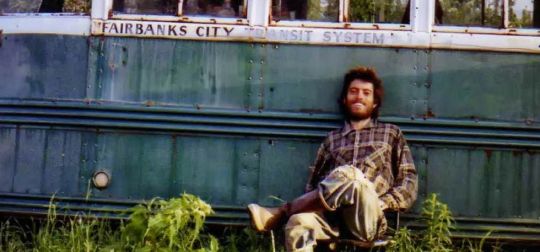
Christopher McCandless, The Man who Hiked to Death
Born February 12th 1968, in Inglewood, California, Christopher McCandless was immediately plunged into a chaotic family. His sister, Carine McCandless, documented in her book ‘The Wild Truth’ that they shared their home with six half-siblings. Carine also alleged that her parents were abusive, both physically and verbally, toward the McCandless children. She documented how her father was an alcoholic, and their mother often fed off his evil energy, inflicting her own abuse upon them.
The McCandless never stayed in one place for long as Walt McCandless worked for NASA as a rocket scientist, taking him across the U.S. Eventually, the family settled in Virginia long enough for Christopher and Carine to graduate.
Following his graduation from university, Christopher knew he needed to travel. He had spent much of his childhood moving from town to town, state to state, and this had a profound impact on his outlook on life.
He only stayed in one place for a short time, seeing the beauty in exploring the world. In mid-1990, Christopher left Virginia for new pastures and began driving West. He stopped in towns and cities along the way, picking up odd jobs to make ends meet. By April of 1992, Christopher was itching for another adventure, and that is when he decided to make his way to Alaska, the final frontier of the U.S.
Incredibly, Christopher managed to hitchhike from Carthage, South Dakota, to Fairbanks, Alaska, a whopping 3,000+ miles through Saskatchewan, Alberta, British Columbia and Yukon, Canada. Eventually, he arrived, and he began planning his largest expedition yet. He wanted to hike through the Denali National Park. The park covers over 6,000,000 acres in the middle of Alaska. Communities are few and far between, with many Alaskans congregating near large towns and cities.
Despite the harsh weather conditions of Alaska, Christopher McCandless seemed ill-prepared. Fellow hikers and locals recalled seeing Christopher arrive in Fairbanks carrying only a backpack. He also stood out for his ‘Hippie-like’ appearance, choosing to remain unkempt and dirty. April 28th 1992, would mark the last day that Christopher McCandless would ever see the seeds of civilisation.
That day, Jim Gallien was flagged down by Christopher, who was looking for a ride to the Stampede Trail in the Denali National Park. Gallien later told author Jon Krakauer that he had doubts about the 24-year-old’s survival from the start. When he got into his car, Christopher had minimal clothing and a backpack. Christopher explained that he was carrying a 10 lb bag of rice, a Remmington semi-automatic rifle and a pair of Wellington boots inside his bag. Gallien was, in fact, so concerned that he offered to drive Christopher to Anchorage so that he could purchase the necessary equipment for him. He knew how harsh and unforgiving the Alaskan landscape could be, and per population, it has an alarmingly high missing persons rate. Throughout their drive, Christopher assured Gallien that he would be fine and had hiked many times before.
It wasn’t until months later that Gallien learned Christopher’s real name, as when he had picked him up, he had simply given the name ‘Alexander Supertramp’. The only item that Christopher accepted from Gallien was a map. Before leaving, Christopher asked Gallien to snap a picture of him at the Stampede Trail, making this one of the last photographs ever taken of Christopher McCandless.
For two days, Christopher hiked the Alaskan wilderness, soaking in the beauty of the Denali National Park. After a gruelling march, Christopher made it to an abandoned blue and white bus. Whilst the exterior was rusted and hadn’t been loved for some time, Christopher recognised it was the perfect shelter and base camp. He wasted no time setting up his gear and prepping his new home.
The blue and white bus that would become a notorious tourist hotspot was not Christopher’s intended finish line. According to his diary, which was later discovered with his body, Christopher had planned to hike through the park and to the Bering Sea. Christopher remained at the blue and white bus for two months, eagerly journaling every step. Christopher wrote in his diary that he had begun consuming the roots of the Hedysarum Alpinum plant. Christopher also detailed in his diary how he had trapped and hunted small game and wildlife. He had successfully hunted a moose/caribou with his rifle. However, the meat was rotten by the time he came to consume it. With just 10 lbs of rice and foraged plants, Christopher rapidly began losing weight.
The lack of food and people was beginning to get to Christopher, who heavily documented his trip via his journal and camera. On July 3rd 1992, Christopher packed up his things, leaving the blue and white bus behind.
With a map in hand, Christopher hoped to reach civilisation once more, but the landscape had changed and he became distressed and returned to the blue and white bus to wait out the days until the river froze over once more.
On July 14th, he also began to incorporate the seeds of the Hedysarum Alpinum plant into his diet, as was documented in his diary. The meagre diet of plant material and small animals was nowhere near enough to sustain Christopher, who continued to waste away. As he continued to weaken, he lost his energy and ability to forage further afield for plants and fruits.
Christopher McCandless made his final diary entry on what he noted as ‘Day 107’. The entry simply reads, “Beautiful blue berries.” Author Krakauer noted that days 108 through 112 had / (slashes) but no words, and after Day 113, no more entries were made. Sometime around these final diary entries, Christopher wrote, “I have had a happy life and thank the Lord. Goodbye, and may God bless all.” It is clear Christopher knew his end was coming, and he had made his final preparations and peace with his fate.
It wasn’t until September 6th 1992 that the grizzly truth would be revealed.
That day, hikers in the Denali National Park came across the blue and white rusted van that Christopher had once called home.
These hikers had the same idea as Christopher and were eager to use the bus as shelter.
When they approached the bus, they found a note taped to the door which read “Attention possible visitors. S.O.S. I need your help; I am injured, near death and too weak to hike out. I am all alone; this is no joke. In the name of God, please remain to save me. I am out collecting berries close by and shall return this evening. Thank you, Chris McCandless, August.”
As they moved through the bus, they saw the familiar outline of a human in a sleeping bag. After reading the note, they hoped that Chris had managed to survive, but all hopes were dashed when the stench of decay overcame them. The hikers took a closer look, and their worst suspicions were confirmed. Christopher McCandless was deceased, his body decaying in a sleeping bag in the back of a rusted-out bus.
Alaska State Troopers and Denali Park staff were summoned to the bus where Christopher’s body was recovered. His family were notified of the terrible news, and preparations for his body to be returned to Virginia were made.
Christopher’s passing marked a turning point in the culture surrounding hiking and travelling. He had wilted away in the wilderness when a bridge and cabin were within a few miles of his location.
37 notes
·
View notes
Text
Another Book Recommendation for 2024
Good Omens by Neil Gaiman and Terry Pratchett
Seems obvious and possibly pointless for the Tumblr audience, but hear me out.
CONTENT WARNING: mention of dark moments in LGBTQ+ history. If you would like to avoid, skip Point #1.
The below notes reflect a discussion concerning the book Good Omens I had with a group of my undergraduate interns over a couple of lunches last semester. Given that they all loved the show, I had assumed they had all read the book. Not all of them had, and for those that did, their knowledge of when the book was originally published and an understanding of its historical context was surprisingly limited. I thought that others may be interested in these points, and so am sharing them here.
1) *SKIP TO AVOID CONTENT WARNING* To understand the impact of Good Omens when it was published in 1990 on the LGBTQIA+ community, it helps to understand the cultural environment at the time of its publishing, at least in the United States.
The book came out towards the end of the height of the AIDS epidemic (1981 - early 90s). I can not stress enough how terrifying this was for the LGBTQIA+ community to live through. People were afraid - of dying, of watching loved ones die, of being separated from their loved ones as they died, of being ostracized, of being denied medical help, of being attacked and beaten. While there was a short fluorescence of nominal acceptance of the LGBTQIA+ community during the 1970s, the societal response to the AIDS epidemic was a huge step backwards. People became cruel(er), whether out of fear or ignorance or opportunity.
Good Omens came quietly onto the scene during this time, providing an alternate universe in which a gay-presenting angel (and his gender-fluid demon friend) could live in a world without the AIDS crisis. At the same time, this angel did live in fear of his world literally ending, and really would like to have just gotten back to his comfy chair and his Regency silver snuffboxes. Escapism reading at its best, really.
In addition, the book was published in 1990, so before many of the cultural moments that helped lead to social change but are now taken for granted. Such as . . . .
-Freddie Mercury died of AIDS in November 1991 (which, by the way, means there was a very short window of time where people were reading Good Omens while he was still alive).
-Sir Elton John came out in 1992
-“Don’t ask, don’t tell” became official policy of the U.S. Military in 1993 (finally repealed in 2011)
-the establishment of LGBTQIA+ centers on college campuses surged in the mid-1990s
-Ellen came out on her show in 1997
-Will and Grace first aired in 1998
-Matthew Shepard was murdered in 1998 (the Federal Hate Crimes Prevention Act bearing his name was not passed until 2007).
2) The book is queer coded for 1990. As queer coded as the show is for current times.
I have heard multiple comments from GenZ students along the lines of ‘there is nothing queer about the book’, and I have read commentary that Neil Gaiman caved to fan pressure in modernizing the script for the show. But I have also heard comments from GenX peers, including one of whom said “it was the gayest book I read in the 90s”. I have highlighted 15 passages in my teaching copy of the book that would have been queer-coded in 1990, 12 of which would go unnoticed today as far as I can tell based on discussions with many of my Millennial and GenZ students.
It is important to keep in mind that the vocabulary of the 1980s and 90s relating to the LGBTQIA+ community was exceedingly limited; Mr. Gaiman and Sir Pratchett worked within this limited vocabulary, and were working within the stereotypes of the times, to portray Crowley and Aziraphale. And readers are meant to love them. Possibly more importantly, the derogatory comments concerning Aziraphale come from unlikable characters, and so the reader not only ends up feeling defensive of the angel but also does not want to be associated with those who hold negative opinions of him. I can think of few better ways to create social change.
In terms of the show adaptation, whenever I watch a movie or show based on a book, my first concern is whether or not the adaptation makes me feel the way the book did. I am not an artist, so I do not know how one translates the written to the visual and I do not envy those attempting to do so. But I do know that successful adaptations are almost never a one-to-one translation. What I can say in this context is that, to me, the show does feel like the book in terms of its themes, its humor, its timely social commentary. So whyever and however Mr. Gaiman updated it, I would argue it was successful.
3) It is my understanding that Good Omens is the first book written by cisgendered heterosexual males for a general audience that portrays a gay-presenting character and a gender-fluid character as main characters in a positive light that does not end in a tragic way. This is huge. This is Captain Kirk and Uhuru’s kiss huge.
Historically, LGBTQIA+ people rarely get positive representation in mainstream media. Rather, LGBTQIA+ characters in literature were often portrayed as villains in early writing, and are often used as comedic relief in more recent work. When there is a sympathetic main character, their story usually ends in tragedy. While tragic stories are very much a reality for many LGBTQIA+ people, it is incredibly important to also have stories that do not end in heartbreak or death. And it is also incredibly important for LGBTQIA+ characters to be part of the norm in main stream story telling as this leads to broader social acceptance. Good Omens provided LGBTQIA+ readers with a sense of belonging in the greater world, while ‘normalizing’ the happy existence of LGBTQIA+ people to a broader readership. This type of representation, presented by heterosexual white cisgendered male authors (at the top of the power structure in 1990) is a key moment in the slow but steady grind leading to social change.
In summary, read the book. Whether you are a fan of the show or not, and regardless of your generation, this book has a lot going for it. Above and beyond its importance to the LGBTQIA+ community, the book includes broader commentary on religion, good vs. evil, right vs. wrong, and identity in general. The menacing humor of Gaiman and the loving satire of Pratchett is a combination that is unequaled. The book is funny, thought-provoking, well-written, and has a lot of great characters above and beyond a particular angel and demon (who are only in about 1/3 of the book). And as you read it, understand its historical context, and love it for the role it played in getting us to this cultural point in time.
45 notes
·
View notes
Text





happy 35th anniversary, Final Fight!
on November 25, 1989, 35 years ago - Final Fight hit the arcades and nothing's been the same since. here's to another 35 and more!
🕹️ you can play Final Fight (SNES) here! 🕹️
🕹️ you can play Final Fight 2 (SNES) here! 🕹️

1989: Final Fight released in arcades, formerly known as "Street Fighter '89"
1990: Final Fight released for SNES
1991: Final Fight released for Commodore Amiga & ZX Spectrum
1992: Final Fight Guy released for SNES (JP)
1993: Mighty Final Fight released for NES, Final Fight 2 released for SNES, Saturday Night Slam Masters released for Arcade, Genesis, SNES
1994: Final Fight Guy released for SNES (NA via rental), Ring of Destruction released
1995: "Medium is the Message" episode airs on the Street Fighter animated series, Final Fight 3 released for SNES, Guy & Sodom released in Street Fighter Alpha 1
1996: Guy's Metro City stage and Rolento's Industrial Stage released with Street Fighter Alpha 2
1997: "Final Fight" episode airs on the Street Fighter animated series, Hugo released with Street Fighter III: 2nd Impact, Cody & Jessica cameo in Mall Mayhem stage in Marvel Super Heroes vs. Street Fighter (Arcade)
1998: Cody & his stage released with Street Fighter Alpha 3
1999: Final Fight Revenge released for Sega Saturn (JP), Cody & Jessica cameo in Mall Mayhem stage in Marvel Super Heroes vs. Street Fighter (PlayStation)
2000:
2001: Final Fight One released for GBA, Rolento & Maki released in Capcom vs. SNK 2: Mark of the Millennium 2001
2002: Rolento & Maki return in the re-release of Capcom vs. SNK 2: Mark of the Millennium 2001
2003: Haggar & Poison developed in Capcom Fighting All-Stars (unreleased, PS2) to protect Metro City from the "Laughing Sun" threat - originally planned sequel to CvS2
2004: Guy released in Capcom Fighting Evolution/Jam released PS2, Haggar, Jessica & Carlos cameo'd in Alex's ending
2005: Capcom Fighting Evolution/Jam released Xbox, Haggar, Jessica & Carlos cameo'd in Alex's ending, Haggar & Guy cameo appearances in Namco × Capcom
2006: Final Fight Streetwise released for PS2/Xbox
2007:
2008:
2009: Final Fight 2 & 3 re-released on Nintendo's Virtual Console
2010: Cody & Guy alongside Metro City's Skyscraper Under Construction released with Super Street Fighter IV, Final Fight: Dbl Impact released for XBLA/PSN alongside Magic Sword
2011: Mike & "New Metro City" released in Marvel vs. Capcom 3, Skyscraper Under Contruction stage featured in Super Street Fighter IV 3D Edition gameplay trailer for Nintendo 3DS
2012: Cody & Guy released as (ondisc) DLC in Street Fighter × Tekken for 360/PS3/PC/iOS/Vita
2013: UDON kicks off Street Fighter Classic
2014: Rolento, Poison, Hugo & Metro City's Mad Gear Hideout stage (re)released alongside Ultra Street Fighter IV alongside bonus "Summer" and "Wild" costume theme packs
2015: Halloween Costumes released for roster of Ultra Street Fighter IV, Kotobukiya Bishoujo Poison figure released
2016: In-depth Final Fight Developer's Interview conducted & published
2017: Abigail & Zeku released as DLC in Street Fighter V, Haggar returns in Marvel vs. Capcom: Infinite
2018: Cody released as DLC in Street Fighter V, Final Fight included on Capcom Beat ’Em Up Bundle, The Broken Gear - A Final Fight Fan Film released on YouTube, the legendary "alchemy" tech used in Final Fight is featured in first episode of Hi-Score Girl via Haggar & Guy
2019: Lucia & Poison released as DLC in Street Fighter V, UDON releases Street Fighter: Wrestlepalooza, Metro City's Ring of Justice (CPT 2019) stage released for SFV
2020: Taylor (Cody), Lucifurr (Lucia), Tamer (Poison), Olde Cat (Zeku), & Tireman (Abigail) available in the cat encyclopedia for April Fools fun in Neco Drop: Cat Friends Nation
2021: Neco Drop 2 returns with Lucifurr (Lucia) as a lead story kitty alongside a "Final Fight Make-Believe" story!, Final Fight 30th Anniversary Art Tribute published by petefighter, streetfighterlegacy & gamebasementcrew
2022: Unbox Industries releases Cody, Guy, Haggar & Hugo soft vinyl limited figures
2023: Final Fight available in Battle Hub & obtainable download in, Metro City featured as primary hub (lore & gameplay-wise), in Street Fighter 6, UDON Comics releases SF6 Origins & Street Fighter Masters: Kimberly #1, "Final Fight Gala" battle pass released via SF6
2024: Udon Comics releases Street Fighter vs. Final Fight #1 for Free Comic Book Day, and Final Fight four-part re-telling series, 52 Toys releases Cody, Guy & Hagar poseable figures, PCS Collectibles releases (alpha) Cody & Guy statue for pre-order
12 notes
·
View notes
Text



FINAL IMPACT (1992) dir. Joseph Merhi, Stephen Smoke
#final impact#final impact 1992#movies#my gifs#gifs#gifset#soupy's#filmedit#filmdaily#filmgifs#moviegifs#cinematv#cinemapix#fyeahmovies#90s#kickboxing#tvandfilm#tvandmovies
12 notes
·
View notes
Text
The Fatherly Gent’s Daunting Text of Magical Shaving and Almanac Japery
(page 542-555)
8/27/2009 Wheel Spin: Dramatic Irony Verdict: Dad’s Note Sadly Qualifies
8/28/2009 Wheel Spin: Captchalogue Lore Verdict: Captchalogue Card Within A Captchalogue Card Within A Captchalogue Card

FINALLY we examine the contents of John’s dad’s safe. John sure likes to take his time with these things. We see the contents before the note, but in my mind the note definitely reframes why Dad might have locked these things away – he wants to give these things to John, not hide them from him, but he’s waiting until John is ‘a man.’ He defines this by physical strength instead of age, maturity, or presence of facial hair, but also by curiosity and the prankster’s spirit. Someone else could be physically able to lift the safe, but never think to do so.
Colonel Sassacre’s Book – As p.543 suggests, this is likely the accidental weapon that caused Nanna’s death, and so this object encapsulates the Egbert family values. Clowning and tomfoolery are highly encouraged, but serious, difficult topics don’t get discussed openly, they get locked away, and communication happens indirectly through notes and pie throwing. This is 50% Dad being uncomfortable with emotions in a way typical of cis men who grew up in the 20th century, and 50% Dad wanting John to have a pure, idyllic childhood away from the realities of the world. I would bet 413 boondollars that Dad locked this up after Nanna’s death and bought John his new copy at the same time, so that John could enjoy the lighthearted pranks of the book without it being tainted by death.
The Fatherly Gent’s Shaving Almanac – This is also likely an heirloom that Dad used to read himself. If Colonel Sassacre’s was originally Nanna’s, this may have originally been Grandad’s. Dad is making some assumptions about John with this one. The first is that he’ll want to shave, even though plenty of people have facial hair by choice. The others are that he’ll be a ‘father’ and a ‘gent.’ The idea that John might not want kids, or might not be a man, doesn’t occur to him. Dad’s vision is that John will grow into exactly the same kind of adult that he is, and possibly that Dad’s dad was too. But this book is also Dad admitting that he had to learn and practice his skills somewhere, showing that he’s a regular human instead of the Eternal Dad who came fully formed from the dad factory that John clearly sees him as right now.
Newspaper clippings – OKAY WHAT THE FUCK. Something weird’s going on here. The clearest article is from Monday, April 13 of either 1970, 1992 or 1998, and the ‘downpour of meteors’ could have happened at 4.13am. Hear me out. The mentions of ‘Local Burb’ (Local Sburb?) and the loss of life being brushed off by authorities means that the people behind Sburb aren’t making their first attempt at causing the apocalypse. It’s their most successful attempt by far, but they’ve been practicing for some time, and are rich and powerful enough to pay off the authorities into covering their tracks. Dad is a baker, and a different clipping says ‘Crocker Facility Leveled.’ Dad developed an interest in meteor news after the factory for his favorite baking company was destroyed by one, and that’s why he collects clippings – keeping them in something that might be strong enough to survive a meteor strike. He’s made some progress towards figuring out who or what is behind all this, but hasn’t finished the work. This is why he showed John Deep Impact and Armageddon as a kid, so that John would have meteors on the brain, and be ready to carry on Dad’s investigative work at some point in the future.
02-49-13 – This safe code was definitely chosen for a reason, but it’s not obvious. It contains a 4-13 (with 4+9 equaling 13) but I’m not sure about the 02. If it was a date, February 49, 2013 would be March 21, 2013, which is shortly before John’s 17th birthday. However, my actual theory – based on this safe being for John, and the fact that John’s birthday is in Dad’s Serious Business screen name – is that 02:49:13 is the time of day (to the second) that John was born. Currently imagining Dad gazing down at his baby son for the first time and thinking ‘I gotta get the time, this is gonna be important later.’
In other news, we learn that a blank captchalogue card is 00000000 (answering @tenaciouschronicler's question) while a card holding another card is 11111111. This is a simple binary option of ‘card or no card,’ and we also see the two straight lines of holes that are punched from the 11111111 code. These facts suggest that the captcha codes make sense (unlike a lot of actual captchas) and that both the codes and the hole patterns can be deciphered and manipulated, which is exciting both for what John could accomplish, and for giving fans something to really dig into.
John Egbert would be nothing without Rose Lalonde. He fully launched his PDA – arguably his most important possession right now – into a yawning void of unknowable darkness, all for the sake of captchaloguing a captchalogued captchalogue card, already kind of a silly thing to do. He got fucking lucky with the Sassacre manuever, and did not earn his ‘pesky urchin’ status or his +5 man grit. I question the line ‘From now on it will probably go without saying that you'll nab any grist lying around without making a big fuss over it.’ on p.542 - can this really go without saying? Can we really give John this much credit?
I love this kid so much, but it really feels like he’s speedrunning growing up and using cheats for character development, with his sylladex, his imp combat and his getting into the safe. He’s not actually ready or able to handle any of these things, not even thinking to move away from the giant hole gazing over the abyss before he puts things into his TWO CARD SYLLADEX, but he’s got computers and somewhat more capable people holding his hand. I am thinking again about Rose’s prediction of hackers, and what might happen if John and Rose are cut off from each other in Sburb, and how John might deal with that.
It’s a hard truth that being a kid often sucks because of how little control you have over your life, but being an adult is really hard and takes a lot of practice, and being a teenager often means sitting at this uncomfortable divide. And it’s literally John’s first day.
#homestuck#reaction#i wish john had focused a lil more on those newspaper clippings!! show me some more i wanna refine my theory........#chrono
14 notes
·
View notes
Text

In 1996, Frank Mendez was one of the most visible people living with HIV in the Rio Grande Valley of South Texas along the US-Mexico border. At a time when the drag community had been impacted heavily by losses to AIDS, Frank was out about his HIV status both in and out of drag and used his platform as Jacqui Fabiane to advocate for safer sex, testing, and education. After testing positive in 1992, Frank became a leading voice in the fight against HIV/AIDS in the Valley and worked as a community health educator for the Valley AIDS Council.
In 1995, several clients protested against the Valley AIDS Council – feeling ignored and taken for granted by the organization's leadership. After launching a hunger strike to incite changes in the agency, Frank left and started his own grassroots group- The McAllen AIDS Coalition.
Needing money to fund his efforts, Frank turned to drag. Since the onset of the AIDS crisis, drag shows had been used to raise money to pay for medical and burial costs for those impacted by AIDS, as well as a forum to educate others about HIV and AIDS. Frank called on four of his fellow drag queens from the local community. The choice was obvious in the Winter of 1996, and they put together a Spice Girls-themed benefit show.
youtube
British girl group The Spice Girls burst onto the scene with their breakout single "Wannabe" in July 1996. It became a global pop sensation seemingly overnight with their brash lyrics and take on "Girl Power" feminism.
The quintet- consisting of Geri Halliwell (Ginger Spice), Melanie Brown (Scary Spice), Emma Bunton (Baby Spice), Melanie Chisolm (Sporty Spice), and Victoria Adams (later Victoria Beckham- Posh Spice)- seemed tailor-made to have a huge queer following- whether it was the larger-than-life camp-inspired outfits donned by Ginger and Scary, Sporty's tomboy aesthetic, or Posh's high-fashion and iconic pout.
Their lyrics celebrating authenticity and expression resonated with many young queer people. For Halloween of 1997, it was common to see groups of five queer friends dressed as the girls. They were also a popular act for drag queens to emulate.
While the group has always embraced its queer following, it was their third single, "2 Become 1," that cemented their status as gay icons- with a lyric change intentionally made to be more inclusive of the community.
youtube
“2 Become 1" is a sensual R&B flavored ballad celebrating intimacy. The original version included on their debut album “Spice” featured a lyric sung by Ginger, "Any deal that we endeavor, boys and girls go good together."
While Ginger quickly became the most popular member of the group, she was the only one who did not have any singing or dancing training. When the group decided to release the song as their next single, she confessed that she had trouble singing her portion and was worried about having to sing it live.
Realizing the original lyric could potentially alienate their growing queer fan base, the girls decided to re-record that portion of the song with new lyrics sung by Posh. The new lyrics, "Once again, if we endeavor, love will bring us back together," - made “2 Become 1” a song that anyone who wanted to "get it on" could relate to.
“2 become 1” became the group’s first Christmas #1 single in the UK in December 1996 and reached #4 in the US the following summer. The song also has an essential nod to the importance of safer sex. Towards the end, Baby sings the final bridge “Be a little bit wiser baby, put it on, put it on…because tonight is the night when 2 Become 1."- a nod to condoms and to navigating sexual safety at a time when AIDS was still ravaging the queer community.
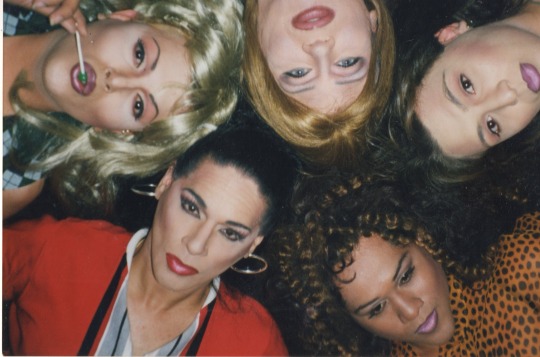
The Spice Girls' connection to queerness went beyond being vocal allies and supporters. In various interviews, Mel B. came out as bisexual- revealing that she had been dating women since her Spice Girl's days. In 2019, she also confirmed long-standing rumors that she and Geri had hooked up during their time in the band.
For Halloween of 1997, the Spice Girls were so ubiquitous that it was common to see groups of five queer friends dressed as the girls. They were also a popular act for drag queens, especially performers who wanted to share the stage with members of their drag families.

For the fundraiser, Frank- the group's leader- was Ginger. Frank's drag mother Takisha More took on the role of Baby- donning her signature pigtails. Takisha was a transgender woman who grew up in San Juan and Edinburg and performed in drag since the 1970s. In 1993, Takisha became the first trans woman to come out publicly on the local news. She was known for her signature high-energy dance moves.
Frank's drag daughter Kanela del Karibe served Sporty Spice with a ponytail and track pants. Kanela was originally from Puerto Rico and moved to the Valley in 1994 with the original plan of moving to San Antonio. She found a community and a voice in drag and decided to stay- remaining in the Valley to this day. She was known for making all of her outfits by hand.
Arden Van York played Scary Spice. Arden was a trans woman from Mission, Texas, of Native Hawai'ian and Mexican descent. She was known for her acrobatic dances- jumping up in the air, doing a flip, and landing in a split at her shows Arden passed away from cancer in 2019.
Rounding out the group was Ty Paris as Posh Spice. Just a few years before, Ty was a young gay teen who found family and community at McAllen, Texas gay bar 10th Ave after becoming the first drag daughter of Valerie Paris - a trans woman from Roma, Texas whose drag house eventually became one of the most prolific in South Texas.

Some of these pictures were taken by Frank’s goddaughter Crystal- who was raised by her mother in a large chosen family that included several drag performers. Crystal would go on to co-found the first GSA in the Valley in 2000.
Instead of hosting the benefit show at a gay bar- which was most common at the time- this group of queens organized their Spice Girls - themed show at a community center in Mercedes, Texas- bringing drag, queer and trans visibility to this small town smack dab in the center of the Valley.
Frank Mendez and his Spice Girls-inspired benefit show in 1997 exemplified the power of community, creativity, and resilience in the fight against HIV/AIDS. By combining activism with entertainment, Frank and his chosen family of drag performers used their platform to raise funds, educate the public, and foster visibility in a region where such efforts were desperately needed.
Written by: Gabriel Sanchez (they/she/he)
Gabriel Sanchez (they/she/he) is a queer and nonbinary native of the Rio Grande Valley of South Texas.
Gabriel is a community historian who has spent the past several years researching, documenting, and sharing the history of the LGBTQIA2S+ community of the Rio Grande Valley and the rich stories of resistance, visibility, and creativity from within this community.
Gabriel curates a pop-up exhibit highlighting this history and a digital archive on Instagram called Pansy Pachanga where they share picture and stories from this community. They are also currently co-directing a documentary of the same name. Gabriel is also a part of various organizations that work to support and celebrate the Rio Grande Valley's LGBTQ+ community including @southtexasequalityproject, @rgvtranscloset, and Casa Kimberly.
This post is in partnership with Pansy Pachanga. Pansy Pachanga is an upcoming documentary about the history of the Rio Grande Valley's LGBTQIA+ community. Follow us for updates and RGV LGBTQIA + history.
#granvarones#pansy pachanga#gay#queer#lgbtq history#latinx#storytelling#spice girls#songs that soundtracked the aids epidemic#Youtube
7 notes
·
View notes
Text
A list of Mae Kent / Matrix Supergirl Official Merchandise
Trading Cards:
1992 Skybox Doomsday: The Death of Superman #61 - And Now -- Supergirl
1992 Skybox Funeral For A Friend #C3 - Action Comics #685
1992 Skybox Funeral For A Friend #C4 - Superman: Man of Steel #20
1992 Skybox Funeral For A Friend #C7 - Action Comics #686
1993 Skybox Return of Superman #1 - Reign of the Supermen!
1993 Skybox Return of Superman #27 - Supergirl!
1993 Skybox Return of Superman #28 - Boy Meets Girl!
1993 Skybox Cosmic Teams #131 - Luthor II
1994 Skybox Superman: Man of Steel #47 - Enter: Supergirl!
1994 Skybox Superman: Man of Steel #64 - Panic in the Sky!
1994 Skybox Superman: Man of Steel #82 - The Vengeance of Supergirl!
1995 DC Pepsi Cards #2 Supergirl
1995 Skybox DC Legends '95 Power Chrome #22 - Supergirl
1995 Fleer/Skybox: DC vs Marvel Impact #11 - Supergirl
1996 Fleer/Skybox: DC Outburst: Firepower #18 - Supergirl
1996 Skybox: Superman Holo Series #19 - Girl of Steel
1996-1997 Fleer/SkyBox : DC OverPower CCG - Supergirl, Cloaking Shield, Levitation, Psychokinetic Bolt, Shapeshift, Telekinetic Shield
Figures/Statues:
2000 DC Direct Supergirl
2004 Headstrong Heroes Supergirl Dynamic Bobble Head
2007 Tonner DC Stars Supergirl
2015 LEGO DC Super Heroes Brainiac Attack Supergirl
2024 POP! COMIC COVERS ACTION COMICS #644 - SUPERMAN (matrix as superman)
Other:
1993 Skybox SkyCaps - Supergirl
1993 DC Previews File Promo Sheet
1994 Skybox Superman: Man of Steel #48 - Final Judgement! (trading card depicting the deaths of the kryptonian criminals from the pocket universe, but not Mae herself.)
1995 Nutella Glass - Australia - Supergirl
#dc comics#mae kent#supergirl#matrix supergirl#dc#superfam#wil talks about mae#figure collecting#trading cards#tcg#mae day#mae kent day
7 notes
·
View notes
Text
Sefarad: La llegada hasta la expulsión (Díaz-Mas y J.S. Gerber)
🇪🇸 En el video se fusionan las narrativas de dos libros sobre la historia de los judíos en España. "Los judíos de España: Una historia de la experiencia sefardí" de Jane S. Gerber, ofrece una visión detallada desde los orígenes bíblicos y la diáspora romana, pasando por la convivencia y prosperidad cultural y económica bajo el dominio musulmán en Córdoba y Granada durante los siglos X y XI, hasta el impacto devastador de la Reconquista y la expulsión de 1492. Se destacan figuras influyentes como Judah Halevi y el florecimiento de la poesía hebrea. Por otro lado, "Breve historia de los judíos en España" de Paloma Díaz-Mas, abarca el crecimiento y las contribuciones de la comunidad judía desde la época romana y visigoda, su papel en la vida económica y cultural medieval, y el deterioro de su situación durante el dominio cristiano, culminando en los pogromos de 1391 y la posterior represión bajo la Inquisición que llevó a la conversión forzada y expulsión en 1492. Ambos textos resaltan el contraste entre la Edad Dorada de coexistencia cultural y el trágico final de más de mil años de presencia judía en la península ibérica.
youtube
🇺🇸 The video combines the narratives of two books about the history of the Jews in Spain. "The Jews of Spain: A History of the Sephardic Experience" by Jane S. Gerber provides a detailed view from biblical origins and the Roman diaspora, through the coexistence and cultural and economic prosperity under Muslim rule in Córdoba and Granada during the 10th and 11th centuries, to the devastating impact of the Reconquista and the expulsion of 1492. Influential figures such as Judah Halevi and the flourishing of Hebrew poetry are highlighted. On the other hand, "A Brief History of the Jews in Spain" by Paloma Díaz-Mas covers the growth and contributions of the Jewish community from Roman and Visigothic times, its role in medieval economic and cultural life, and the deterioration of its situation under Christian rule, culminating in the pogroms of 1391 and the subsequent repression under the Inquisition that led to forced conversion and expulsion in 1492. Both texts emphasize the contrast between the Golden Age of cultural coexistence and the tragic end of over a thousand years of Jewish presence on the Iberian Peninsula.
Díaz-Mas, Paloma. Breve historia de los judíos en España. Los Libros De La Catarata, 2023.
Gerber, Jane S. The Jews of Spain: A History of the Sephardic Experience. Free Press, 1992.
#judaísmo#sefardí#España#Córdoba#Granada#Inquisición#expulsión#Reconquista#convivencia#Edad Media#Paloma Díaz-Mas#Jane S. Gerber#judíos#Sefarad#Al-Ándalus#reinos cristianos#nacimiento#orígenes#diáspora judía#Judaism#Sephardic#Spain#Inquisition#expulsion#coexistence#Middle Ages#Jews#Sepharad#Al-Andalus#Christian kingdoms
5 notes
·
View notes